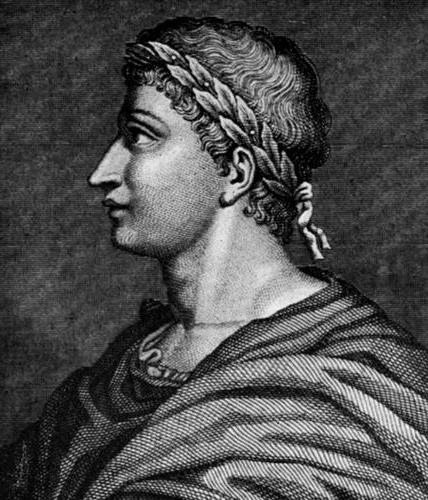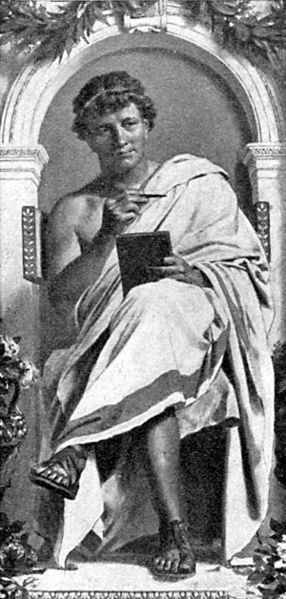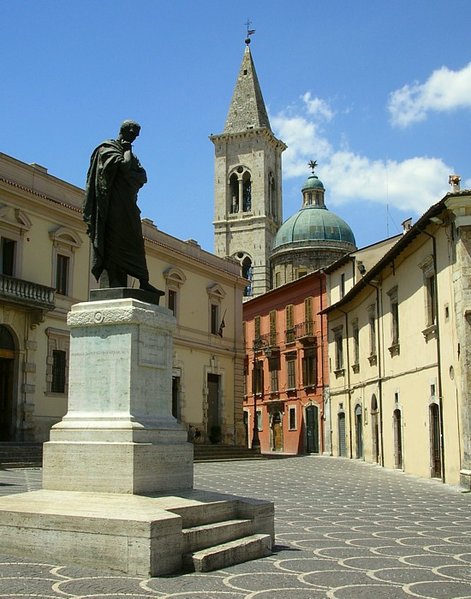<Back to Index>
- Chemist Torbern Olof Bergman, 1735
- Poet Publius Ovidius Naso (Ovid), 43 B.C.
- Sultan of the Ottoman Empire Abdul Hamid I, 1725
PAGE SPONSOR



Publius Ovidius Naso (20 March 43 BC – AD 17/18), known as Ovid in the English speaking world, was a Roman poet who is best known as the author of the three major collections of erotic poetry: Heroides, Amores, and Ars Amatoria. He is also well known for the Metamorphoses, a mythological hexameter poem; the Fasti, about the Roman calendar; and the Tristia and Epistulae ex Ponto, two collections of poems written in exile on the Black Sea. Ovid was also the author of several smaller pieces, the Remedia Amoris, the Medicamina Faciei Femineae, and the long curse poem Ibis. He also authored a lost tragedy, Medea. He is considered a master of the elegiac couplet, and is traditionally ranked alongside Virgil and Horace as one of the three canonic poets of Latin literature. The scholar Quintilian considered him the last of the canonical Latin love elegists. His poetry, much imitated during Late Antiquity and the Middle Ages, decisively influenced European art and literature and remains as one of the most important sources of classical mythology.
Ovid talks more about his own life than most other Roman poets. Information about his biography is drawn primarily from his poetry, especially Tristia 4.10, which gives a long autobiographical account of his life. Other sources include Seneca and Quintilian.
Ovid was born in Sulmo (Sulmona), in an Apennine valley east of Rome, to an important equestrian family, on March 20, 43 BC, a significant year in Roman politics. He was educated in Rome in rhetoric under the teachers Arellius Fuscus and Porcius Latro with his brother who excelled at oratory. His father wished him to study rhetoric toward the practice of law. According to Seneca the Elder, Ovid tended to the emotional, not the argumentative pole of rhetoric. After the death of his brother at 20 years of age, Ovid renounced law and began travelling to Athens, Asia Minor, and Sicily. He held minor public posts, as one of the tresviri capitales and as one of the decemviri stlitibus iudicandis, but resigned to pursue poetry probably around 29 – 25 BC, a decision of which his father apparently disapproved. His first recitation has been dated to around 25 BC, when Ovid was eighteen. He was part of the circle centered upon the patron Marcus Valerius Messalla Corvinus, but seems to have been friends with poets in the circle of Maecenas. In Trist. 4.10.41–54, Ovid mentions friendships with Macer, Propertius, Horace, and Bassus (he only barely met Virgil and Tibullus, a fellow member of Messalla's circle whose elegies he admired greatly). Ovid was very popular at the time of his early works, but was later exiled by Augustus in 8 AD. He married three times and divorced twice by the time he was thirty years old. However, he only had one daughter who eventually bore him grandchildren. His last wife was part of the influential gens Sulpicia and would help him during his exile in Tomis.
The first 25 years of Ovid's literary career were spent primarily writing poetry in elegiac meter with erotic themes. The chronology of these early works is not secure; tentative dates, however, have been established by scholars. His earliest extant work is thought to be the Heroides, letters of mythological heroines to their absent lovers, which may have been published in 19 BC, although the date is uncertain as it depends on a notice in Am.2.18.19–26, which seems to describe the collection as an early published work. The authenticity of various of these poems has been challenged but this first edition probably contained the first 14 poems of the collection. The first five book collection of the Amores, a series of erotic poems addressed to a lover, Corinna, is thought to have been published in 16–15 BC; the surviving, extant version, redacted to three books according to an epigram prefixed to the first book, is thought to have been published c. 8–3 BC. Between the publications of the two editions of the Amores can be dated the premiere of his tragedy Medea which was admired in antiquity but is now no longer extant. Ovid's next poem, the Medicamina Faciei, a fragmentary work on women's beauty treatments preceded the Ars Amatoria, the Art of Love, a parody of didactic poetry and a three-book manual about seduction and intrigue, which has been dated to 2 AD. Ovid may identify this work in his exile poetry as the carmen, or song, which was one cause of his banishment. The Ars Amatoria was followed by the Remedia Amoris in the same year. This corpus of elegiac, erotic poetry earned Ovid a place among the chief Roman elegists Gallus, Tibullus, and Propertius, of which he saw himself as the fourth member.
By 8 AD, he had completed his most ambitious work, the Metamorphoses, a hexameter epic poem in 15 books which encyclopedically catalogues transformations in Greek and Roman mythology from the emergence of the cosmos to the deification of Julius Caesar. The stories follow each other in the telling of human beings transformed to new bodies — trees, rocks, animals, flowers, constellations et cetera. At the same time, he was working on the Fasti, a six-book poem in elegiac couplets which took the Roman festivals calendar and astronomy as its theme. The composition of this poem was interrupted by Ovid's exile, and it is thought that Ovid abandoned work on the piece in Tomis. It is likely in this period, if they are indeed by Ovid, that the double letters (16 – 21) in the Heroides were composed.
In 8 AD, Ovid was banished to Tomis, on the Black Sea, by the exclusive intervention of the Emperor Augustus, without any participation of the Senate or of any Roman judge, an event which would shape all of his following poetry. Ovid wrote that the reason for his exile was carmen et error — "a poem and a mistake", claiming that his crime was worse than murder, more harmful than poetry. The Emperor's grandchildren, Agrippa Postumus and Julia the Younger, were banished around the time of his banishment; Julia's husband, Lucius Aemilius Paullus, was put to death for conspiracy against Augustus, a conspiracy about which Ovid might have known. The Julian Marriage Laws of 18 BC, which promoted monogamous marriage to increase the population's birth rate, were fresh in the Roman mind. Ovid's writing in the Ars Amatoria concerned the serious crime of adultery,
and he may have been banished for these works which appeared subversive
to the emperor's moral legislation. However, because of the long
distance of time between the publication of this work (1 BC) and the
exile (8 AD), some authors suggest that Augustus used the poem as a
mere justification for something more personal. In exile, Ovid wrote two poetry collections titled Tristia and Epistulae ex Ponto,
illustrating his sadness and desolation. Being far from Rome, he had no
access to libraries, and thus might have been forced to abandon the Fasti poem about the Roman calendar, of which only the first six books exist — January through June. The five books of the elegiac Tristia, a series of poems expressing the poet's despair in exile and advocating his return to Rome, are dated to 9–12 AD. The Ibis, an elegiac curse poem attacking an adversary at home may also be dated to this period. The Epistulae ex Ponto,
a series of letters to friends in Rome asking them to effect his
return, are thought to be his last compositions, with the first three
books published in 13 AD and the fourth book between 14 and 16 AD. The
exile poetry is particularly emotive and personal. In the Epistulae he claims friendship with the natives of Tomis (in the Tristia they
are frightening barbarians) and to have written a poem in their
language (Ex P. 4.13.19–20). And yet he pined for Rome and for his
third wife, as many of the poems are to her. Some are also to the
Emperor Augustus,
yet others are to himself, to friends in Rome, and sometimes to the
poems themselves, expressing loneliness and hope of recall from
banishment or exile. The
obscure causes of Ovid's exile have given rise to endless explanations
from scholars studying antiquity. In fact, the mediaeval texts that
mention the exile offer no credible explanations as their statements
seem incorrect interpretations drawn from the works of Ovid. Ovid himself wrote many references to his offense giving obscure or contradictory clues. In
1923, scholar J.J. Hartmann proposed a theory that is little
considered among scholars of Latin civilization today — that Ovid never
left Rome to the exile and that all of his exile works are the result
of his fertile imagination. This theory was supported and rejected in
the 1930s, especially by Dutch authors. In 1985 a new research paper by Fitton Brown advanced new arguments in support of the theory; the article was followed by a series of supports and refutations in the short space of five years. Among the reasons argued by Brown is: that Ovid's exile is only informed by his own work, except in "dubious" passages by Pliny the Elder, Statius, but no other author until the 4th century; that the author of Heroides was able to separate the poetic "I" of his own and real life; that information on the geography of Tomis were already known by Virgil, Herodotus and by Ovid himself in his Metamorphoses. Orthodox scholars, however, are opposed to these hypotheses. One of the main arguments of these scholars is that Ovid wouldn't let his Fasti remain unfinished, mainly because this poem meant his consecration as imperial poet. Ovid died at Tomis after some ten years. It is thought that the Fasti,
which he spent time revising, were published posthumously. He was
allegedly buried a few kilometers away in a nearby town. In 1930 that
town was renamed Ovidiu in his honor. As Ovid spent the last years of his life and literary work in what is now Romania,
Romanian nationalists have adopted him as "The First Romanian Poet" and
placed him in the pantheon of Romanian national heroes. Ovidiu is a common male first name in Romania. Also, a statue commemorates him in the Romanian city of Tomis (contemporary Constantza). The statue's Latin inscription reads (Tristia 3.3.73–76): Ovid
is traditionally considered the final significant love elegist in the
evolution of the genre and one of the most versatile in his handling of
the genre's conventions. Ovid, like the other canonical elegiac poets
takes on a persona in his works which emphasizes subjectivity and
personal emotion over traditional militaristic and public goals, a
convention which has been linked by some scholars with the relative
stability provided by the Augustan settlement. However, although Catullus, Tibullus and Propertius may
have been inspired in part by personal experience (the validity of
"biographical" readings of these poets' works is a serious point of
scholarly contention) Ovid
has been seen as taking on a persona in his poetry which is far more
emotionally detached from his mistress and less involved in crafting a
unique emotional realism within the text than the other elegists. This attitude, coupled with the lack of testimony which identifies Ovid's Corinna with a real person has
led scholars to conclude that Corinna was never a real person and that
Ovid's relationship with her is an invention for his elegiac project. Some scholars have even interpreted Corinna as a metapoetic symbol for the elegiac genre itself. Ovid
has been considered a highly inventive love elegist who plays with
traditional elegiac conventions and elaborates the themes of the genre; Quintilian even calls him a "sportive" elegist. In some poems, he uses traditional conventions in new ways, such as the paraklausithyron of Am. 1.6,
while other poems seem to have no elegiac precedents and appear to be
Ovid's own generic innovations, such as the poem on Corinna's ruined
hair (Am. 1.14). Ovid has been traditionally seen as far more sexually explicit in his poetry than the other elegists. His erotic elegy covers a wide spectrum of themes and viewpoints; the Amores focus on Ovid's relationship with Corinna, the love of mythical characters is the subject of the Heroides, and the Ars Amatoria and
the other didactic love poems provide a handbook for relationships and
seduction from a (mock-)"scientific" point of view. In his treatment of
elegy, scholars have traced the influence of rhetorical education in his enumeration, in his effects of surprise, and in his transitional devices. Some commentators have also noted the influence Ovid's interest in love elegy in his other works, such as the Fasti and have distinguished his "elegiac" style from his "epic" style. Richard Heinze in his famous Ovids elegische Erzählung delineated the distinction between Ovid's styles by comparing the Fasti and Metamorphoses versions of the same legends such as the treatment of Ceres - Proserpina story
in both poems. Heinze demonstrated that, "whereas in the elegiac poems
a sentimental and tender tone prevails, the hexameter narrative is
characterized by an emphasis on solemnity and awe..." His general line of argument has been accepted by Brooks Otis, who wrote: Otis wrote that in the Ovidian poems of love, he "was burlesquing an old theme rather than inventing a new one." Otis states that the Heroides are
more serious and, though some of them are "quite different from
anything Ovid had done before [...] he is here also treading a very
well-worn path" to relate that the motif of females abandoned by or
separated from their men was a "stock motif of Hellenistic and neoteric poetry (the classic example for us is, of course, Catullus 66)." Otis also states that Phaedra and Medea, Dido and Hermione (also presents in the poem) "are clever re-touchings of Euripides and Vergil." Some
scholars, such as Kenney and Clausen, has compared Ovid with Virgil.
According to them, Virgil was ambiguous and ambivalent while Ovid was
defined and, while Ovid wrote only what he could express Virgil wrote
for the use of language. Ovid's
works have been interpreted in various ways over the centuries with
attitudes that depended on the social, religious and literary contexts
of different times. It is known that since his own lifetime, he was
already famous and criticized. In the Remedia Amoris, Ovid reports criticism from people who considered his books insolent. Ovid
responded to this criticism by writing the following: "Gluttonous Envy,
burst: my name’s well known already:/it will be more so, if only my
feet travel the road they’ve started./But you’re in too much of a
hurry: if I live you’ll be more than sorry:/many poems, in fact, are
forming in my mind." After such criticism subsided, Ovid became one of the best known and most loved Roman poets during the Middle Ages and the Renaissance. The authors of the Middle Ages used his work as a way to read and write about sex and violence without orthodox "scrutiny routinely given to commentaries on the Bible". In the Middle Ages the voluminous Ovide Moralisé, a French work that moralizes 15 books of the Metamorphoses was composed. This work then influenced Chaucer.
Ovid's poetry provided insipration for the Renaissance idea of
humanism, and more specifically, for many Renaissance painters and
writers. Montaigne, for example, alluded to Ovid several times in his Essais, specifically in his comments on Education of Children when he says: